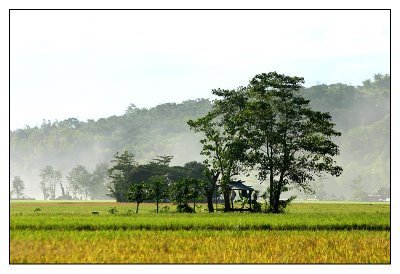
After my father opted for an early retirement from his work, the family moved back to Bohol in the mid nineties. My mom owns a few hectares of farm land and my parents decided to give farming a shot. And besides, the children have grown up and moved out. In fact, life on the farm won’t be so bad and would be ideal for retiring.
Accustomed to a more leisurely life in cool, hilly and pine-crested Bukidnon, adjusting to life in, get this—Buyog Ilaud, Getafe Bohol—took some time. My former office colleague Chelo, laughed her guts out when she heard this. I found out later she hails from a town in Agusan del Norte with a name no better than mine: Bayugan.
Buyog Ilaud is a barrio nestled among the hills that dot Getafe’s landscape. From the main highway going to Getafe town from Tagbilaran, you take a dirt road upon reaching a main curve right after passing a huge bridge in Buenavista. Further off, a winding gravel-and-clayish road leads you right to the barrio.
A typical village, the generally simple folks, poor, hardy but genial, live by subsistence farming, mostly dependent on rice and coconuts, as the soil, clayish and limey, does not lend itself suitable for other farm crops, with the exception of cassava.
I had a difficult time adjusting to this place. You see, the hills block the sea breeze coming in through the coastal areas, turning the area into a virtual oven during summer months—dry air, high humidity, soaring temperatures. It’s better now that some of the breadfruit trees my mom planted have developed canopies that provide the all-important shade and cover during searing hot periods, and the verdant Bermuda grass that carpets the front yard provides a welcome sight from the reddish earth that turns to a sticky mud when it rains.
Our house used to be the only one in the barrio that has indoor plumbing, as our neighbors contented themselves with fetching water everyday and taking communal baths near the barrio well. During the house construction, however, we found it extremely difficult to adjust. Going to and fro the communal well requires skills meant for a tight-rope walker: You had to pass through steep, perilous and slippery foot paths while carrying huge water containers on your shoulders. I slipped a couple of times. So did my brother, to the villagers’ utter amusement. Oh yes, we were like celebrities, mind you.
Electric supply is erratic. Intermittent black outs are a normal occurrence, although to be fair, it does not last long. You learn to cope. Of course there’s no cable. What did you expect? We had no choice but watch inane shows by ABS-CBN.
And since there are only about ten or so houses in the barrio, it could be eerily quiet in the daytime when most of the villagers are in the fields and the children are in school. It is perfect for settling yourself in a divan in the front lawn leafing through that thick Dickens novel you have so long wanted to finish, or pound your way through Rachmaninoff’s bombastic preludes, for all you care. Like most Filipinos, videoke singing is the favorite past time in the village. You’d be up in the hill maybe 10kms away and you could still hear Nang Salome belting her lungs out, “And I did it…Myyyy…Wi! By six in the evening everybody is inside; by nine the lights are already out! Imagine that.
I am not familiar with the place at all. I get lost in the woods. I couldn’t find my way through the thicket of coconut groves, wild berry trees, rows of cacao and terraced rice fields. I love the sight of greening rice though, lush and verdant and as the first grains appear, the scarecrows and bells made of tin cans suspended by a string and tied from both ends of the field drive the birds away.
I do not have many acquaintances in the barrio, nearby villages and in town. Although some of them are relatives, I honestly do not know them. When I’m home, I usually stay inside, resting. I rarely venture out, unless my parents require me to make pakisama. It doesn’t help that these people tend to be shy, obsequious and deferential. I do not particularly go out of my way to mix myself with their company, or go the extra mile just so I get a good impression among them.
Ok, ok. I’m a baaad person. Snap out of it! I can live with it.
This is home, all right. But sometimes, it doesn’t feel like one. My childhood memories, school, my acquaintances and friends, other than my family of course—the things that make you feel “at home” are conspicuously absent.
But I visit once in a while, twice or thrice a year. My parents occupy the small three-bedroom house by themselves. I’m sure it gets pretty lonely there at times, although my nephews and nieces visit occasionally from the city.
1 comment:
Hahaha. Welcome to my world dude. When my dad retired the family also went back to their "hometown" in Agusan del Norte. I dread holidays in that place because I don't know anyone. Oh well.
Post a Comment